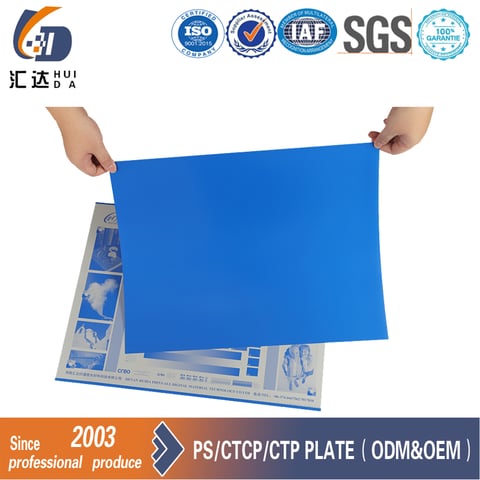
Henan Huida Prinect Technology Co., Ltd. has sorted out 8 precautions for using CTP for you, hoping to help you operate better in daily use:
1. Maintain a stable indoor environment
Check the temperature and humidity in the CTP working room every day. The temperature should be 24-26°C, and the humidity should be 40%-70%. The room should be equipped with a humidifying and dehumidifying machine to facilitate the adjustment of humidity. The temperature in the north is low in winter, and the air conditioner should be turned on 24 hours a day to keep the indoor temperature and humidity suitable day and night. If the indoor humidity is sufficient, but the smell of medicine is too strong, you can turn on the exhaust fan. Mop the floor with a damp mop every morning. If conditions permit, put on clean slippers before entering the CTP work room, and close the door after entering. Non-CTP operators are restricted from entering to maintain indoor temperature and humidity and prevent dust.
2. Switch on and off correctly
Before starting the machine, check whether there is any debris around the CTP and whether the power cord and the upper and lower water pipes are connected correctly. After starting up, check whether the UPS, air compressor, and other equipment start normally and whether the self-test of the plate processor is normal. When starting up, pay attention to the starting sequence. You should first turn on the power of the host computer, and then turn on the CTP after the host computer is started to ensure normal communication between the computer and the CTP. When shutting down, first turn off the CTP in the CTP control program in the computer, and then turn off the computer power.
3. Calibration plate linearization
When doing the linearization calibration of the printing plate, be careful not to apply protective glue, otherwise, the measured dot value will be slightly larger than the actual dot value.
4. Check the pipeline
It should be confirmed that the liquid level in the protective glue and developer replenishment barrel is normal because if there is a shortage of liquid, the system will not alarm. Open the upper cover of the plate processing machine, press the forced plate feed button, start the spray pipe to spray water, and observe whether the water spray in the spray part is normal (if there is a booster pump, confirm that the booster pump is working normally). At the same time, check whether the water spray hole is leaking or clogged. If it is found to be clogged, you can use a paper clip to clear it. But pay attention to safety during operation to prevent the roller from pinching your hands. The discharge valve of the spray tank should be opened and kept dry.
5. Make the equipment reach the best condition
After turning on the machine every day, when the developing temperature of the processor is suitable, a waste plate should be washed first, or the processor should be forced to run for a period of time so that the developing solution can be mixed evenly. When making map printing plates, try to output the black plate and brown plate (for line printing) first, and then output the blue plate and green plate (for dot printing) after the performance of the developer solution is fully exerted, which is conducive to dot reproduction.
6. Proper access to plates
CTP plates should be stored in a dry and cool place, the storage temperature is 5-30°C, and the humidity is not more than 55%. Pay attention to moisture, extrusion, acid, and alkali.
Under normal circumstances, the plate should stand obliquely on the wall or on the frame. When taking out the plate, you should take out the last plate, take out the backing paper in front of the film, put the plate on the upper plate, and then remove the backing paper, so as to prevent fingerprints from being printed on the plate surface. The plate should be handled with care and not curled arbitrarily, so as to avoid creases that make the plate uneven and affect the exposure effect. Be careful not to send two plates into the CTP at the same time.
Although heat-sensitive plates are not sensitive to common light sources, in order to prevent accidents, care should also be taken to prevent long-term direct exposure to sunlight and fluorescent lamps during use.
7. Do regular inspections
Regularly open the upper cover of the washing machine, check whether there is dirt or crystallization on the developing rubber roller, and clean it if necessary. For the rubber roller with crystals in the developing tank, it can be taken out and placed in the sink, soaked in a mixture of oxalic acid and water for ten minutes, and then scrubbed with water. Other rubber rollers only need to be rinsed with water. If the equipment is not used for a long time (such as the Spring Festival holiday, etc.), the developing liquid and protective glue should be discharged, and then the equipment should be thoroughly cleaned with clean water. It is worth noting that it is best to start the machine and add some water to clean the glue supply pipeline, otherwise, the glue supply pipeline may be blocked due to the drying of the protective glue.
8. Check the layout
The quality requirements for the developed layout are as follows: the layout should not have scratches and dirty spots; the layout should be fully developed; the overprinting lines and corner lines of the layout should be complete, and if there are any missing, remedial measures should be taken in time, and the position of the jaws should be correct.
Huida Print-All Technology company is an advanced and professional manufacturer of producing printing plates, mainly sales CTP, CTCP, and PS plates as well as offering ODM/OEMs, especially for the offset. For more information, please click the official website link here: https://www.huidaoffsetplate.com/.
